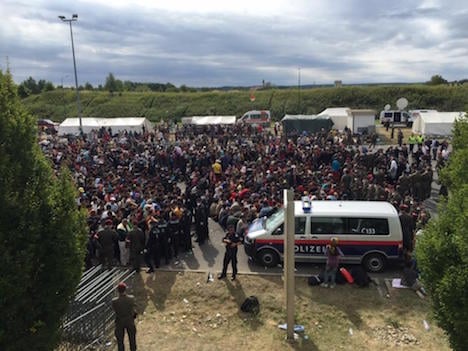In the latest chapter in the EU's escalating refugee crisis, Croatia, Hungary and Slovenia tussled over how to cope with the massive inflow of people passing through on their way to new lives in northern and western Europe.
The European Union, meanwhile, sketched out plans to boost aid to encourage Syrians in Turkey to stay put rather than join the exodus.
Hungary's right-wing government, which has faced international criticism over violent clashes with migrants and a hastily erected fence along its frontier with Serbia, has vowed to “defend its borders” against the flood of new arrivals, most of whom are from the Middle East and Africa.
But in a shift in tactics late Friday, Hungarian authorities began transporting thousands of migrants straight to the border with Austria, an apparent bid to move them through and out of their territory as quickly as possible.
Austrian police said Hungary had bussed at least 6,700 people to the border, with a total of 10,000 arrivals expected in the Burgenland border region by the end of Saturday.
Ground-level coordination
There was no let-up in the stream of people making the gruelling journey across the Balkans into western Europe, with Croatia saying 20,700 had entered the country since Wednesday.
Zagreb, which initially said it would allow migrants to pass through freely, announced it was swamped on Friday and began transporting hundreds to the Hungarian border by bus and train — sparking a furious reaction from Budapest.
Despite the row, Croatian and Hungarian authorities appeared to be coordinating on the ground. An AFP journalist along the frontier between the two countries saw migrants board Croatian buses that took them to the border, before disembarking and crossing on foot then boarding Hungarian buses that quickly departed.
Migrants were being transported on Friday to two border crossings with Hungary and two with Slovenia, Interior Minister Ranko Ostojic said. Both countries belong to Europe's borderless Schengen zone.
Hungary's barbed wire fence grows
In a new hurdle aimed at stemming the influx, Hungary said it had completed a 41-kilometre (25-mile) barbed-wire barrier along part of its frontier with Croatia.
It “was finished overnight Friday,” defence spokesman Attila Kovacs told AFP in Budapest.
The remaining 330 km of the border runs roughly along the Drava river, which is difficult to cross.
The new barrier adds to a barbed-wire fence that Hungary completed along its frontier with Serbia earlier this week, backed with laws threatening illegal migrants with jail, which forced the migrant flow towards neighbouring Croatia.
The first migrants to have taken this diverted new route — through Croatia and Slovenia — arrived in Austria on Saturday, from where many hope to travel on to elsewhere in the European Union.
About 150 people crossed the border, local police said, and were being looked after by the Red Cross in the state of Styria.
A step behind them, on the Croatia-Slovenia frontier, aid tents have sprung up with local and foreign volunteers giving out food, water and clothes.
“It's generous of them,” said Khaddam Ghaiath, a Syrian former customs official who is on the road with his 70-year-old mother.
“It must be a shock for them to see thousands of people arriving like this. It is not a normal situation.”
Tensions boiled over at the Croatian border town of Harmica overnight, with Slovenian riot police using pepper spray against several hundred migrants, some with children, who had sought to push through their cordon into Slovenia, an AFP photographer saw.
The clash happened shortly after Slovenian Prime Minister Miro Cerar said the small country might consider creating “corridors” for refugees wanting to reach northern Europe if they continue arriving in large numbers.
Slovenian police said on Saturday that 1,287 had arrived as of midnight Friday, of which 483 were from Afghanistan, 470 from Syria and 126 from Iraq.
German warning
Figures released Friday showed the EU received almost a quarter of a million asylum requests in the three months to June, while the International Organization for Migration (IOM) said nearly 474,000 people had so far this year braved perilous trips across the Mediterranean to reach Europe.
Italy's coastguard on Saturday said it had picked up more than 4,500 people off the Libyan coast, as calm seas sparked a flurry of attempts to make the crossing.
The continent's biggest migratory flow since the end of World War II has dug a deep rift between western and eastern EU members over how to distribute the migrants fairly.
Another worry is over the fate of the Schengen agreement, a pillar of the European integration project that allows borderless travel between member states.
Germany, Europe's biggest economy, is the great magnet for the migrants, expecting up to a million asylum seekers this year.
But the country's Interior Minister Thomas de Maiziere said Saturday that the EU should in future should take a finite number of migrants, while sending the rest back to a safe country in their home regions.
“We cannot accept all the people who are fleeing conflict zones or poverty and want to come to Europe or Germany,” Thomas de Maiziere said in an interview with news weekly Spiegel.
EU interior ministers are to meet again on Tuesday, followed by an emergency summit on Wednesday.
Turkish solution?
Meanwhile, European leaders called for more action to tackle the problem at one of its sources — Turkey, from where many of the migrants have travelled, including tens of thousands of Syrian refugees.
European Commissioner Johannes Hahn said Saturday the EU was earmarking aid of “up to one billion euros” ($1.13 billion) to encourage Syrian refugees in Turkey to stay there rather than join the outpouring of people heading to Europe.
Austrian Chancellor Werner Faymann and German Vice Chancellor Sigmar Gabriel meanwhile issued a joint call for United Nations countries to contribute an extra five billion euros ($5.65 billion) in aid for refugees living in camps in Lebanon and Jordan.
Of the more than four million Syrians who have fled their country, nearly half have sought shelter in Turkey, while more than a million are now living in Lebanon and at least 600,000 in Jordan.
Leaders urge aid boost
Austrian Chancellor Werner Faymann and German Vice Chancellor Sigmar Gabriel on Saturday called for United Nations countries to contribute an extra five billion euros ($5.65 billion) in aid for refugees living in camps in Lebanon and Jordan.
“We have to help countries where the misery is so great that people are going on the road,” Gabriel said, in reference to the tens of thousands of migrants — many of them Syrian refugees — who have headed to Europe in recent months.
“If people have nothing to eat and drink, what can they do but flee? No barrier in the world will stop them,” Gabriel told a press conference.
In a thinly veiled reference to Hungary, which has been fencing off its borders in a bid to keep the migrants out, Faymann said: “A country can build a fence and try to pass on the responsibility to provide humanitarian aid to its neighbours,” but added that “international solidarity” is needed to solve the crisis.
The United Nations estimates that Jordan is hosting 600,000 Syrian refugees, while the government puts the figure at up to 1.4 million.
Tiny Lebanon, which has a population of only four million, is currently hosting more than 1.1 million Syrians forced from their homes by their country's brutal civil war.
Berlin called last week at a meeting of G7 and Arab countries for more funds for the UN refugee agency.
Europe is facing its biggest migration crisis since World War II as it struggles to cope with a massive influx of migrants fleeing conflict and poverty in the Middle East and elsewhere.
The International Organization for Migration said this week that nearly 474,000 people braved perilous trips across the Mediterranean to reach Europe this year.



 Please whitelist us to continue reading.
Please whitelist us to continue reading.